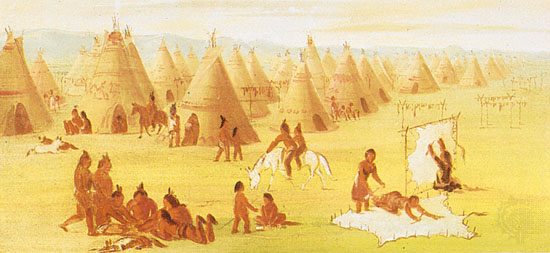|
|
|
The Comanche
|
They were a nomadic tribe who hunted buffalo and in the 18th and 19th centuries, roved the southern Great Plains. The Comanche were an offshoot of the Wyoming Shoshoni, their language was Shoshonean, and prior to their migration south, they had been semisedentary hunters and gatherers. They moved south in successive stages, attacking and displacing other Plains tribes, notably the Apache, whom they drove from the southern plains. By the early 1800s the Comanche were a powerful tribe, with a population estimated at between 7,000 and 10,000. Their language, of the Shoshonean branch of the Uto-Aztecan linguistic stock, became a lingua franca for much of the area. The Comanche were organized in 12 or so autonomous bands--local groups that lacked the lineages, clans, military societies, and tribal government of most other Plains Indians. Prior to 1874, the Comanche did not perform the sun dance or any other integrating tribal ceremony. Their staple food was buffalo meat, which also provided them with robes, covering for their tepees, sinew thread, and water carriers made of the animal's stomach. The Comanche were one of the first tribes to acquire horses from the Spanish and one of the few to breed them to any extent. The highly skilled Comanche horsemen set the pattern of equestrian nomadism that became so characteristic of the Plains Indians in the 18th and 19th centuries. Comanche raids for booty and captives carried them as far south as Durango in Mexico. In the mid-19th century the Penateka, or southern branch of the Comanche, were settled on a reservation in Indian Territory (now Oklahoma). The northern segment of the tribe, however, continued the struggle to protect the hunting grounds from white settlers. In 1864 Christopher ("Kit") Carson led U.S. forces in an unsuccessful campaign against them. In 1865 the Comanche and their allies the Kiowa signed a treaty with the United States, which granted them what is now western Oklahoma from the Red River north to the Cimarron. Upon U.S. failure to abide by the terms of the treaty, hostilities resumed until 1867, when, in agreements made at Medicine Lodge Creek in Kansas, the Comanche, Kiowa, and Kiowa Apache undertook to settle on a reservation in Oklahoma. The government, however, was unable to keep whites off the land promised to the Indians, and it was after this date that some of the most terrible encounters between U.S. forces and the Comanche took place. In the late 20th century about 3,000 Comanche were living on individual holdings in the vicinity of Lawton, Oklahoma. |
 |
|
"Comanche
Village, Women Dressing Robes and Drying Meat"
detail of a painting by George Catlin, 1834-35 In the National Museum of American Art, Washington, D.C. By courtesy of the National Museum of American Art, Smithsonian Institution, Washington, D.C.; gift of Mrs. Joseph Harrison, Jr. |
![]()
Plains Indians
: Intro
The Sioux : Dakota ~
Dhegiha ~ Chiewere ~ Mandan
~ Hidatsa
The Caddo : Arikara
~ Pawnee ~ Wichita
The Shoshonean : Comanche ~ Kiowa
The Alqonquian : Blackfeet ~ Gros Ventre ~ Cheyenne
~ Arapaho ~ Plains Cree ~ Plains Ojibwa
Crazy Horse ~~ Red Cloud ~~ Sitting Bull
![]()
Where We Critters Live
Kaws || Wichitas
|| Plains Indians
Kansas || Wichita
The Infamous || Tornado!
Main
SiteGuide
~~~~~~~~~~~~~~~~~~~~~~~~~~~~~~~~~~~~~~~~~~~